Contents
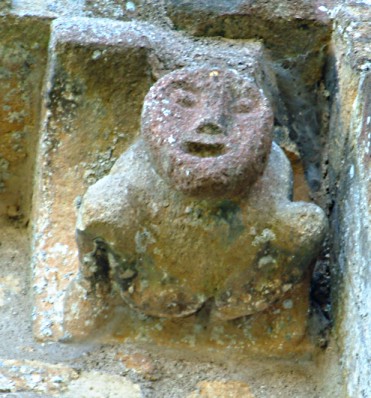
The Church
Abstract corbels, an astrological tympanum, St Michael slaying the dragon and host of other architectural features make Stoke Sub Hamdon a veritable feast of medieval carving.
The church has been added to many time over the centuries resulting in a many different features from different times. The church is thought to have been originally built in 1100 the first version of the church not having a tower. This figure and a later nude figure on the church is discussed in the paper Two Sheila-na-gigs at Stoke Sub Hamdon by Paul Ashdown in Somerset Archaeology and Natural History 1993.
The Figure
The figure can be found on the left side of the church as you enter from the main gate. Walk past the tower and you should find a series of Romanesque corbels. The picture below indicates the exact position.
At first glance the figure is unremarkable just a face staring out from a squatting body. However when you go directly beneath the figure you can clearly see a cleft indicating either buttocks or a vagina. Unfortunately it is hard to from the carving which it is meant to be. There also seems to be some indication of hands pulling a the cleft apart but this not clear. While the figure is undoubtedly exhibitionist is it a sheela? Well it has all the characteristics of a sheela except for the fact that it’s exhibitionist nature is not immediately obvious. It is not as “in your face” as the Kilpeck or Oaksey sheelas and has less of an impact. In fact you have to go out of your way to discover that the figure is indeed exhibitionist at all. The same goes for the later figure on the rear of the church (see below) mentioned in Paul Ashdown’s paper.
This later figure (right) can be found on the rear of the church high up on the back wall. It consists of a nude figure with it’s mouth wide open which is blocked by a piece of rubble. The figure is missing the right hand limbs but gestures to the vulva with it’s left hand. The vulva is not immediately obvious and it was only due to the fact that we had read John Ashdown’s paper that we noticed it. In fact both myself and Keith Jones missed this figure on several separate visits despite the fact we were looking for figures of this type. The figure appears to have been moved from elsewhere and looks like the type of gargoyle figure you see adorning later medieval church towers. If this is the case then the figure would have faced head outwards with the feet on the tower while a channel would have been set to make waste water emerge from the mouth. If this description holds true then the vulva would have been facing the church and would not have been immediately obvious. There is also some indication that the vulva may have been carved at a later date than the main figure as it appears to be out of line with the main body. If you look at the photograph above you can see that if you draw a vertical line through the vulva it points to beyond the figure’s left shoulder rather than straight up to the head.
Once again we are faced with the question of the definition of a Sheela na gig. This figure lacks the overt exhibitionism of the Kilpeck and Oaksey figures in much the same way as the earlier Romanesque corbel on the other side of the church. Nevertheless it is displaying it’s vulva (if not in an immediately shocking way) This and the fact that stylistically it appears to much later than the usual Romanesque period, makes it one of the latest vulva displaying figures in the UK.
The rest of the church is very interesting with many different carvings dotted around it. There are some corbels which very abstract in design and would not look out of place in an Escher drawing. In addition to these some carvings (see below) are very odd defying a simple explanation of what they are meant to represent.
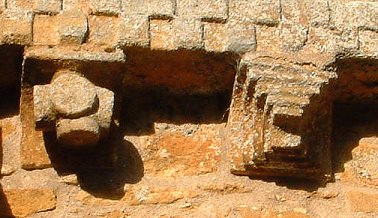
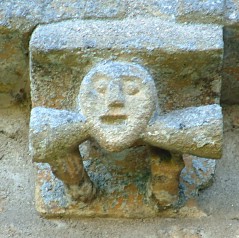
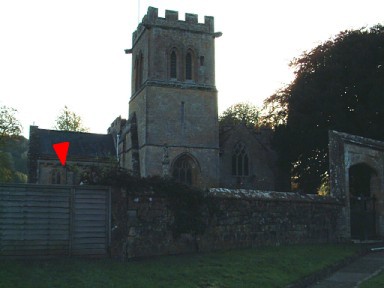
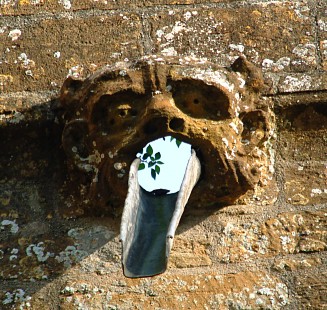
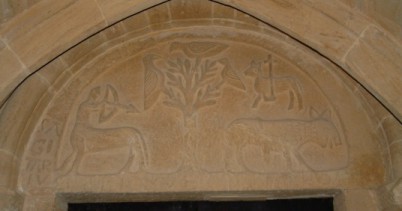
Tympanum over the main door to the church containing the astrological symbols of Saggitarius and Leo.
Interestingly the Sagitarius/Leo motif is duplicated on the font at Hook Norton including the explicit naming of the figures with inscriptions.